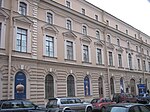Senate and Synod Building
1834 establishments in the Russian EmpireBuildings and structures in Saint PetersburgCarlo Rossi buildings and structuresCultural heritage monuments of federal significance in Saint PetersburgGovernment buildings completed in 1834 ... and 2 more
Neoclassical architecture in RussiaTourist attractions in Saint Petersburg

The Senate and Synod Building is the former headquarters of the Governing Senate and the Most Holy Synod of the Russian Empire in the Senate Square, Central St. Petersburg, Russia and the current headquarters of the Russian Constitutional Court and Boris Yeltsin Presidential Library.
Excerpt from the Wikipedia article Senate and Synod Building (License: CC BY-SA 3.0, Authors, Images).Senate and Synod Building
Senate square, Saint Petersburg
Geographical coordinates (GPS) Address Website Nearby Places Show on map
Geographical coordinates (GPS)
| Latitude | Longitude |
|---|---|
| N 59.935833333333 ° | E 30.300555555556 ° |
Address
Конституционный суд Российской Федерации
Senate square
191011 Saint Petersburg (Адмиралтейский округ)
Saint Petersburg, Russia
Open on Google Maps










